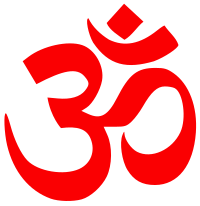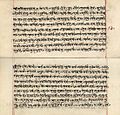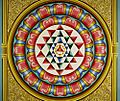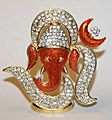Aum facts for kids
Om (also spelled Aum) is a very special and sacred symbol in Hinduism. It's like a powerful sound or word that Hindus use when they pray or meditate. Many Hindu scriptures talk about this symbol and its deep meaning. In Hinduism, saying "Om" is like calling out to God. People often say it three times before starting any prayers or chants. Om is often connected to the Hindu God Shiva, who is known as the destroyer god.
Contents
What is Om?
Om is more than just a sound; it's seen as the sound of the universe. It represents everything that exists, has existed, and will exist. It's considered the most important sound in many Indian religions.
The Three Sounds of Om
The word "Om" is actually made up of three sounds: A, U, and M.
- A (pronounced "Ahhh") stands for the beginning of everything, like when you wake up.
- U (pronounced "Oooo") stands for the middle, like when you are awake and living life.
- M (pronounced "Mmmm") stands for the end, like deep sleep or the end of a cycle.
When you put them together, "Om" represents the whole journey of life and the universe.
Om in Daily Life
You can find Om everywhere in Hindu culture.
- Many people chant "Om" during meditation to help them focus and feel peaceful.
- It's often written on temples, religious items, and even jewelry.
- It's a symbol of peace, harmony, and the connection to something bigger than ourselves.
Om and Other Deities
While Om is often linked with Shiva, it's also connected to other Hindu gods. For example, the Hindu deity Ganesha is sometimes called "Omkara," meaning his form is Om. This shows how important and widespread the symbol is in different parts of Hinduism.
Images for kids
-
A rangoli featuring Om surrounded by stylised peacocks; Om often features prominently in the religious art and iconography of Indic religions
-
Statue depicting Shiva as the Nataraja dancing in a posture resembling the Devangari ligature for Om; Joseph Campbell argued that the Nataraja statue represents Om as a symbol of the entirety of "consciousness, universe" and "the message that God is within a person and without"
-
Om appears frequently in Hindu texts and scriptures, notably appearing in the first verse of the Rigveda
-
Om is given many meanings and layers of symbolism in the Upanishads including "the sacred sound, the Yes!, the Vedas, the udgitha (song of the universe), the infinite, the all encompassing, the whole world, the truth, the ultimate reality, the finest essence, the cause of the universe, the essence of life, the Brahman, the ātman, the vehicle of deepest knowledge, and self-knowledge (atma jnana)".
-
Shri Yantra with Om (ௐ) at its center, Sri Mariamman Temple, Singapore; yantras are frequently used as aids in Hindu meditation
-
The Hindu deity Ganesha is sometimes referred to as "oṃkārasvarūpa" (Omkara is his form) and used as the symbol for Upanishadic concept of Brahman.
-
Om symbol with a trishula at Kanaka Durga Temple, Vijayawada
See also
 In Spanish: Om para niños
In Spanish: Om para niños
















